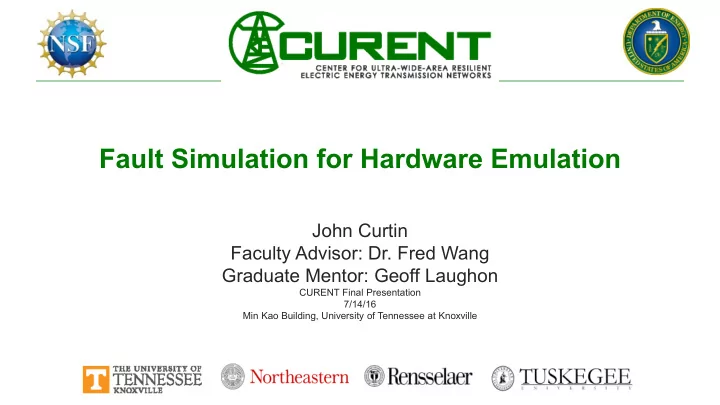

Fault Simulation for Hardware Emulation John Curtin Faculty Advisor: Dr. Fred Wang Graduate Mentor: Geoff Laughon CURENT Final Presentation 7/14/16 Min Kao Building, University of Tennessee at Knoxville
Faults • Many different kinds Example: Line-to-Line • Large amounts of power dissipation • Caused by fault current 5-2
Faults (Continued) • Other kinds: Line-to-Ground, Double-Line-to-Ground, Three-phase, open-circuit • Cause massive disturbances in power systems Can damage/destroy equipment Causes power outages • Fault current important parameter in protection systems 5-3
Hardware Test Bed (HTB) • Hardware simulation of power grid • Made up of several hardware racks • More realistic than software 5-4
Hardware Test Bed (HTB) (Continued) • Uses AC-to-DC power converters Coupled for loads and generators • Uses short line approximation • Can simulate open-circuit faults 5-5
Hardware Construction/Design • Worked extensively building cabinets • Involved metalwork, soldering, crimping, wiring, and so on • Important skills for engineers 5-6
Problem Statement • To help the HTB accurately simulate faults Includes pre-fault, transient, and post-fault current waveforms • Create Simulink Simulation • Use to make C code to control power converters • Known values Sending voltage Receiving voltage Line impedance Fault impedance Fault location Start and End time • Calculate Line and Fault Currents 5-7
Background Research • Traditional fault analysis Uses phasor-domain analysis Not adequate for research project Does not incorporate transient • Researched several topics, including: Z-bus method Generator Stability d-q coordinates 5-8
Background Research (Continued) • Decided method s-domain transfer function s= σ +j ω Continuous, all-inclusive variable Constraints of s-domain do not conflict with project constraints • Use circuit analysis with Z=R+sL 5-9
Implementation • Model circuits Example: L-to-G • Before Fault • After Fault iF=iA-ia 5-10
Simulation • Put mathematical models into Simulink Note: not using circuit simulation tools Make model as close to C code as possible • Static Transfer Function Does not give transient effect 5-11
Simulation (Continued) • Dynamic Transfer Function Variable coefficients Switch with step functions Attempted several methods Ran out of time 5-12
Conclusion • Wrong research topics Consumed time • Learned interesting topics • Create Dynamic transfer function in future 5-13
Acknowledgements This work was supported primarily by the ERC Program of the National Science Foundation and DOE under NSF Award Number EEC-1041877. Other US government and industrial sponsors of CURENT research are also gratefully acknowledged. 14
Acknowledgements • I would like to thank the following people Dr. Fred Wang Dr. Kevin Tomsavic Dr. Gerald Selvaggi Geoff Laughon Bo Liu Yiwei Ma Jessica Boles Shuoting Zhang 5-15
Questions and Answers 16
Recommend
More recommend